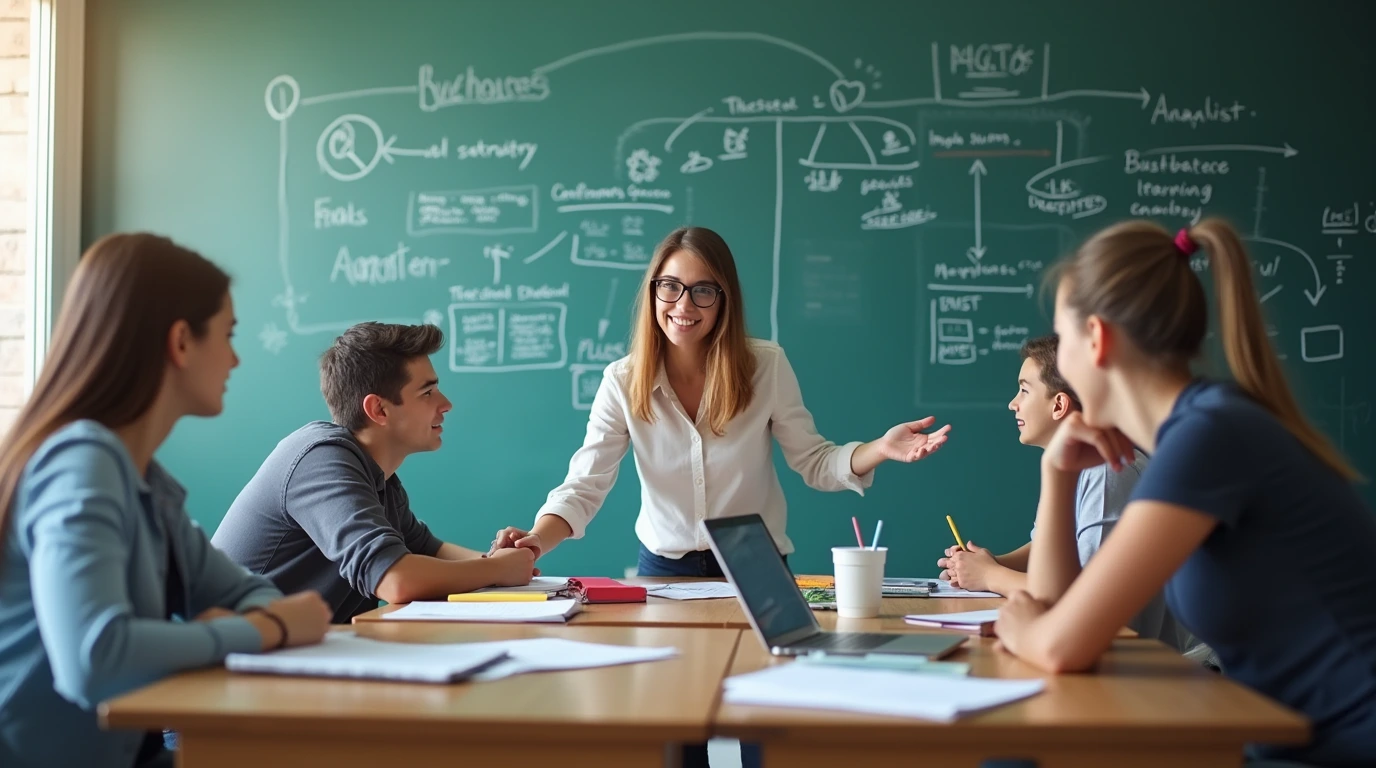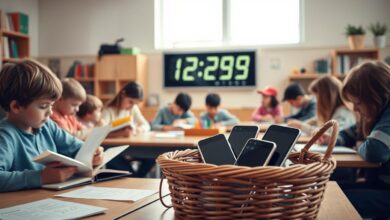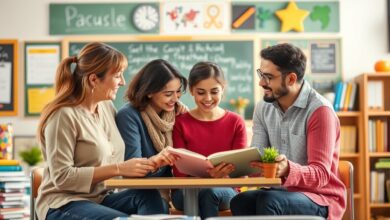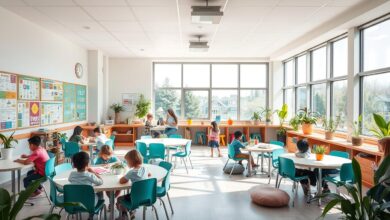Engaging Lessons: Boost Student Interest & Achievement

Table of Contents
In the modern world of education, I recognize the importance of creating engaging lessons. These lessons must capture students’ attention and motivate them to learn.
Effective teaching isn’t just about transferring information. It requires creative strategies that attract students and encourage their active participation.
This comprehensive guide is for teachers who want to transform their lessons. I’ll share techniques and methods that help turn the classroom into a vibrant space.
Introduction to the Importance of Interactive Teaching in Modern Education
In the age of technology, interactive teaching has become the foundation of modern education. Classrooms have transformed into dynamic learning environments that rely on active participation and interaction.
Modern education plays a major role in developing students’ skills. Interactive teaching creates a stimulating learning environment. This environment encourages students to:
- Participate positively
- Think critically
- Solve problems creatively
- Develop communication skills
To illustrate the importance of interactive teaching, let’s review some key features:
| Features of Interactive Teaching | Impact on the Educational Process |
|---|---|
| Increased focus and attention | Improved information retention |
| Development of thinking skills | Enhanced creative abilities |
| Building self-confidence | Encouraging active participation |
Interactive teaching is not just a method of instruction; it is a comprehensive approach aimed at empowering students to learn more deeply and effectively.
Interactive teaching is considered key to transforming education. It shifts from a process of rote learning to a genuine and enjoyable learning experience. It helps students understand content and connect it to reality more deeply.
The Engaging Lesson and Its Impact on Academic Achievement

Interactive learning plays a significant role in improving student achievement. It’s important to create a learning environment that helps students focus and learn better.
The Relationship Between Student Interest and Academic Achievement
Student interest is key to academic success. The more focused a student is, the better their achievement. This relationship can be summarized in the following points:
- Increased intrinsic motivation for learning
- Improved ability to comprehend information
- Development of critical thinking skills
How Interaction Affects Long-Term Memory
Classroom interaction enhances long-term memory. When a student participates in learning, information is more deeply ingrained in their memory.
The Role of Motivation in the Learning Process
Motivation is very important for achieving academic success. I can provide strategies to increase motivation:
- Connecting educational content to real-world applications
- Using diverse teaching methods
- Providing positive feedback
| Learning Element | Impact on Achievement |
|---|---|
| Interest | 60% increase in academic performance |
| Interaction | 45% improvement in comprehension |
| Motivation | 55% increase in drive |
“Education is not the filling of a pail, but the lighting of a fire” – A phrase that summarizes the essence of effective teaching.
Creative Teaching Strategies in the Classroom

I am always looking for new ways to make classroom teaching more creative. I want to make students think and interact. Creativity transforms the learning process from just a task into a unique adventure.
Here are some exciting ways to make teaching more creative:
- Project-based learning: Helps students solve problems
- Collaborative learning: Enhances communication and teamwork
- Educational games: Make learning more interactive
- Critical thinking: Encourages students to ask questions and analyze information
To make creative teaching strategies successful, they must be flexible and innovative. I want to create an active learning environment where the student is at the center of the process.
Creativity in teaching makes it more passionate for students.
By integrating these strategies, we create a space for innovation and thinking in the classroom.
The Role of Technology in Enhancing Lesson Appeal
Technology has become a powerful tool in education. It helps transform the learning experience. In our era, digital tools have become more important in capturing students’ attention.
Digital Tools to Improve Engagement
I use a variety of digital tools to increase interaction in the classroom:
- Interactive e-learning platforms
- Smart quiz applications
- Advanced presentation tools
Interactive Educational Applications
I use specialized educational applications to make learning enjoyable. These applications help students to:
- Easily understand complex concepts
- Directly interact with educational content
- Develop critical thinking skills
Integrating Multimedia into Teaching
I believe strongly in the power of multimedia to enhance student comprehension. By using videos, animations, and interactive images, we create a rich learning environment.
| Media Type | Educational Benefits |
|---|---|
| Educational videos | Visually clarify complex concepts |
| Interactive animations | Increase focus and interaction |
| Dynamic illustrative images | Simplify complex information |
Methods of Motivation and Participation in the Classroom
Motivating students and increasing classroom participation are significant challenges. I recognize the importance of creating an interactive and enjoyable learning environment. This environment encourages students to actively participate.
There are many methods to stimulate classroom interaction:
- Asking open-ended questions that stimulate critical thinking
- Encouraging teamwork and collaborative learning
- Using interactive techniques in explanations
- Providing continuous positive feedback
Motivation methods are very important for improving participation. I suggest using diverse strategies to capture students’ attention:
| Method | Goal | Expected Outcome |
|---|---|---|
| Interactive discussions | Encourage critical thinking | Increased student participation |
| Educational games | Make learning enjoyable | Improved motivation |
| Project-based learning | Develop teamwork skills | Enhanced interaction |
The primary goal is to create a stimulating learning environment that encourages students to express themselves freely and confidently.
I believe that diversity in motivational methods helps break routines. This helps motivate students to participate more actively in the educational process.
Designing Engaging Educational Activities
Designing engaging educational activities is a major challenge for teachers today. I am always looking for innovative ways to capture students’ attention and motivate them to learn.
Purposeful Educational Games
Educational games help make learning fun and interactive. They can be integrated into the classroom in different ways:
- Designing competitive games that promote critical thinking
- Using interactive educational applications
- Creating educational simulation games
Stimulating Group Projects
Group projects enhance collaboration and communication skills. It’s important to design projects that stimulate creativity and teamwork.
| Project Type | Skills Acquired |
|---|---|
| Scientific research project | Scientific thinking, information gathering |
| Joint art project | Creativity, teamwork |
| Problem-solving project | Critical thinking, collaboration |
By integrating educational activities, games, and group projects, we create an interactive and inspiring learning environment.
“True learning happens when the student is enthusiastic and actively involved.”
Building a Learning Environment Conducive to Creativity

I always use methods to create a learning environment that fosters creativity. This environment encourages students to think freely and learn effectively. The classrooms I use are designed to stimulate creativity and encourage participation.
To create a stimulating learning environment, I emphasize several points:
- Designing a flexible and attractive learning space
- Providing diverse tools and resources
- Encouraging interaction and open dialogue
- Supporting initiative and experimentation
I care about creating an atmosphere that allows students to ask questions and explore their ideas freely. Positive reinforcement opens new horizons for learning and creativity.
| Elements of a Stimulating Learning Environment | Educational Impact |
|---|---|
| Flexible spaces for group work | Increased interaction and collaboration |
| Modern educational technologies | Enhanced interactive learning |
| Diverse creative activities | Development of higher-order thinking skills |
“Creativity is not a talent; it’s a way of thinking that can be learned and developed.”
I aim to create classrooms that help students discover their potential. I also want to develop their creative skills in an enjoyable way.
Developing Teacher Presentation Skills
A teacher’s performance is crucial for educational success. Presentation skills are essential for creating an engaging learning environment.
Effective Body Language
Body language is important in classroom communication. It helps in:
- Clearly conveying information
- Capturing students’ attention
- Building a positive relationship
Impactful Communication Skills
Teachers should develop communication skills. This can be done through:
- Controlling voice tone
- Using gestures naturally
- Maintaining eye contact
“Good communication is the key to successful education.”
These skills increase students’ understanding and focus. They make lessons more enjoyable and effective.
Connecting Educational Content to Real-Life Applications
I recognize the importance of practical application in learning. This comes from our ability to bridge the gap between theoretical knowledge and reality. When we connect education to reality, we open new horizons for students.
The power of real learning is evident in examples from daily life. These examples make abstract concepts tangible. I suggest several strategies to achieve this goal:
- Using real-world case studies
- Organizing field trips
- Inviting specialists to speak with students
- Designing practical projects
In science, we transform theories into practical experiments. In mathematics, we connect equations to everyday life situations. This helps students understand the importance of what they are learning.
Effective education is that which makes knowledge alive and vibrant with reality.
I always aim to create a learning experience that extends beyond the classroom walls. Learning becomes an exciting and enjoyable journey of discovery.
Conclusion
Our journey in the world of teaching has shown us the importance of understanding changes in the learning environment. Creativity opens the doors to success in improving the quality of education. Teachers must be flexible to accommodate the diverse needs of students.
Advice for teachers emphasizes the importance of using technology and interactive methods. Every lesson is an opportunity for new innovation. Every student holds unique potential waiting to be discovered.
I invite every teacher to experiment and venture into the world of education. They must maintain passion and creativity. Education is a continuous journey, not an end, and every day is an opportunity to make learning an inspiring experience.
Frequently Asked Questions (FAQ): Making Lessons More Engaging
How can I make my lesson more engaging?
To make your lesson engaging, use educational games and collaborative learning. Connecting content to real life is also important. Always, encouraging active student participation is key.
What is the importance of technology in making lessons engaging?
Technology is very important for lesson appeal. Interactive applications can be used to clarify concepts. This captures students’ attention in an innovative way.
How can students be motivated to participate in the lesson?
Asking open-ended questions and encouraging discussions are important. Creating a supportive environment for students allows them to express themselves. Positive feedback enhances student participation.
What are the benefits of collaborative learning?
Collaborative learning enhances teamwork skills. It develops communication and allows for the exchange of ideas. Dividing students into groups creates opportunities for shared learning.
How can educational content be connected to real-life applications?
Providing real-world examples and case studies is important. This shows how concepts apply in the real world. It helps students understand the importance of what they are learning.



